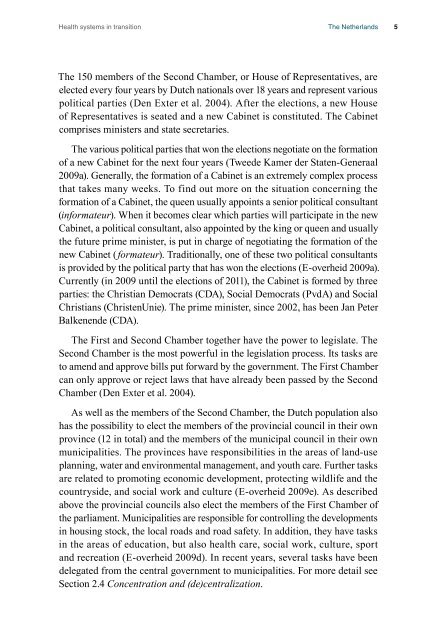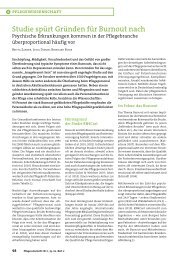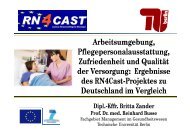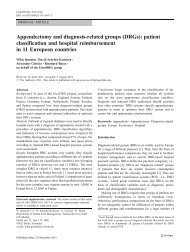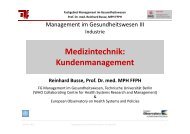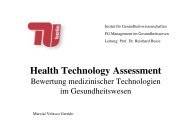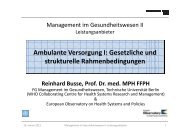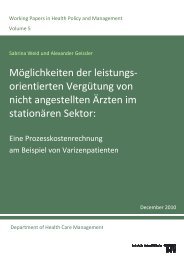The Netherlands: Health System Review 2010
The Netherlands: Health System Review 2010
The Netherlands: Health System Review 2010
You also want an ePaper? Increase the reach of your titles
YUMPU automatically turns print PDFs into web optimized ePapers that Google loves.
<strong>Health</strong> systems in transition <strong>The</strong> <strong>Netherlands</strong> 5<br />
<strong>The</strong> 150 members of the Second Chamber, or House of Representatives, are<br />
elected every four years by Dutch nationals over 18 years and represent various<br />
political parties (Den Exter et al. 2004). After the elections, a new House<br />
of Representatives is seated and a new Cabinet is constituted. <strong>The</strong> Cabinet<br />
comprises ministers and state secretaries.<br />
<strong>The</strong> various political parties that won the elections negotiate on the formation<br />
of a new Cabinet for the next four years (Tweede Kamer der Staten-Generaal<br />
2009a). Generally, the formation of a Cabinet is an extremely complex process<br />
that takes many weeks. To find out more on the situation concerning the<br />
formation of a Cabinet, the queen usually appoints a senior political consultant<br />
(informateur). When it becomes clear which parties will participate in the new<br />
Cabinet, a political consultant, also appointed by the king or queen and usually<br />
the future prime minister, is put in charge of negotiating the formation of the<br />
new Cabinet (formateur). Traditionally, one of these two political consultants<br />
is provided by the political party that has won the elections (E-overheid 2009a).<br />
Currently (in 2009 until the elections of 2011), the Cabinet is formed by three<br />
parties: the Christian Democrats (CDA), Social Democrats (PvdA) and Social<br />
Christians (ChristenUnie). <strong>The</strong> prime minister, since 2002, has been Jan Peter<br />
Balkenende (CDA).<br />
<strong>The</strong> First and Second Chamber together have the power to legislate. <strong>The</strong><br />
Second Chamber is the most powerful in the legislation process. Its tasks are<br />
to amend and approve bills put forward by the government. <strong>The</strong> First Chamber<br />
can only approve or reject laws that have already been passed by the Second<br />
Chamber (Den Exter et al. 2004).<br />
As well as the members of the Second Chamber, the Dutch population also<br />
has the possibility to elect the members of the provincial council in their own<br />
province (12 in total) and the members of the municipal council in their own<br />
municipalities. <strong>The</strong> provinces have responsibilities in the areas of land-use<br />
planning, water and environmental management, and youth care. Further tasks<br />
are related to promoting economic development, protecting wildlife and the<br />
countryside, and social work and culture (E-overheid 2009e). As described<br />
above the provincial councils also elect the members of the First Chamber of<br />
the parliament. Municipalities are responsible for controlling the developments<br />
in housing stock, the local roads and road safety. In addition, they have tasks<br />
in the areas of education, but also health care, social work, culture, sport<br />
and recreation (E-overheid 2009d). In recent years, several tasks have been<br />
delegated from the central government to municipalities. For more detail see<br />
Section 2.4 Concentration and (de)centralization.


